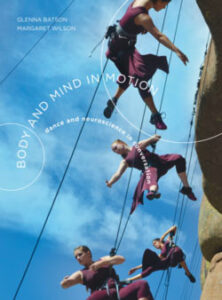Glenna Batson

- Primary Focus: Somatics within dance & health
- Location: Durham, North Carolina USA
Brief description of Current Primary Focus:
For nearly five decades, I have advanced a trans-disciplinary approach to movement studies as catalysts for teaching, research, and artistic and personal growth. I draw from dance, Somatics, and other embodiment studies (performance, phenomenology), human movement science, and rehabilitation medicine. I teach both in the USA and in Europe, applying somatic principles to performance as well as health and wellness.
Education and Certifications:
Masters (MA) in Dance Education, Columbia University Teachers College, New York (1978)
Masters (MS) in Physical Therapy, Hahnemann Medical University, Philadelphia, PA (1983)
Doctor of Science (ScD) in Physical Therapy, Rocky Mountain University of Health Professions, Provo, UT (2006)
Learning Experiences Related to Mabel Todd’s Educational Legacy:
I was the first person trained by Irene Dowd, protégé of Dr. Lulu Sweigard, in 1977. I remained under her gracious tutelage until 1982, as apprentice and co-facilitator of workshops in New York City. I have continued to use Ideokinesis for embodied learning and neuromuscular re-education in workshops, clinical settings, and practice-based research.
Professional activities, areas of research, or personal inquiry:
Currently, I am adjunct faculty in the Masters in Fine Arts in Dance at Duke University, teaching Somatics: Embodiment for the 21st Century. In this course, Ideokinesis plays a spotlight role. I have evolved a form of practice-based research called Human Origami, an approach to exploring the dynamics and aesthetics of bodily folding through movement improvisation. A large part of the research lies in expanding the role of language in movement learning, particularly the role of kinesthetic and visual imagery as verbal prompts for new movement discovery and creation.
My co-facilitator is multimedia artist Susan Sentler (LASALLE College of the Arts, Singapore). Together, the work has extended into multiple disciplines beyond dance/movement training and performance – bioscience, auditory- and computer science, and fashion design. The following publications explore some of those directions:
Glenna Batson, “Intimate to ultimate: The meta-kinesthetic flow of embodied consciousness,” in A. Williamson, S. Whatley, G. Batson & R. Weber, Dance, Somatics and Spiritualities: Contemporary Sacred Narratives, Intellect/University of Chicago Press, 2014, pp. 221-238. https://press.uchicago.edu/index.html
Glenna Batson, “Sharing creativity through the mirror neuron system,” in Lynn Book & David Phillips, eds. Creativity and Entrepreneurship: Changing Currents in Education and Public Life, Northampton, MA, Edward Elgar, 2013, pp. 66-76. https://www.e-elgar.com
Susan Sentler and Glenna Batson, entering the fold – art making as embodied enquiry, Intellect Books, UK out early 2024. https://www.intellectbooks.com
— Glenna Batson (2023)

Body and Mind in Motion is available at The University of Chicago Press.
Bibliography for Glenna Batson
Batson, G. “The Role of Somatic Education in Dance Medicine and Rehabilitation,” North Carolina Medical Journal 54(2): 74-77, 1993.
Batson, G. “Stretching technique: a somatic learning model. Part I.” Impulse: The International Journal of Dance Science, Medicine, and Education. 1993; 1:5-15.
——– “Stretching Technique: A Somatic Learning Model. Part II.” Impulse: The International Journal of Dance Science, Medicine, and Education. 1993; 2:18-29.
——— “Joint Health in Dancers: Identifying Risk factors for Osteoarthrosis and Promoting Preventive Measures,” Impulse 4(1): 11-26, January, 1996.
——— “Building your Library: Support for Mental Imagery,” Dance Teacher Now July/August: 19-20, 22, 1997.
——– “Motor imagery for stroke rehabilitation: current research as a guide to clinical practice.” Alternative & Complementary Therapies. 2004; 10: 84-89.
——– “The Somatic practice of intentional rest in dance education – Preliminary steps towards a method of study.” Journal of Dance and Somatic Practices, 2010; 1(2): 177-197.
——– “Exercise-induced central fatigue – A frontier for dance science research.” Special Issue on Overuse in Dance Training – Journal of Dance Medicine and Science, 2013; 17 (3): 92-100.
Batson, G. and Sentler S. “Visual and tactile-kinesthetic imagery – a neuro-phenomenological distinction in improvisational dance praxis.” Journal of Dance and Somatic Practices, 2017; 9(2): 195-213.
Batson, G. and Wilson MA. “Rest and Recovery: Making it Doable for Dancers.” In Wilmerding, V. and Krasnow, D., (Eds.), Dancer Wellness, Champaign, IL: Human Kinetics Press, 2016.
Batson, G. and Wilson, MA. Body and Mind in Motion: Dance and Neuroscience in Conversation. Chicago, IL: University of Chicago Press, 2014.
© 2023 The Thinking Body Institute. All rights reserved. Reprint with permission only.